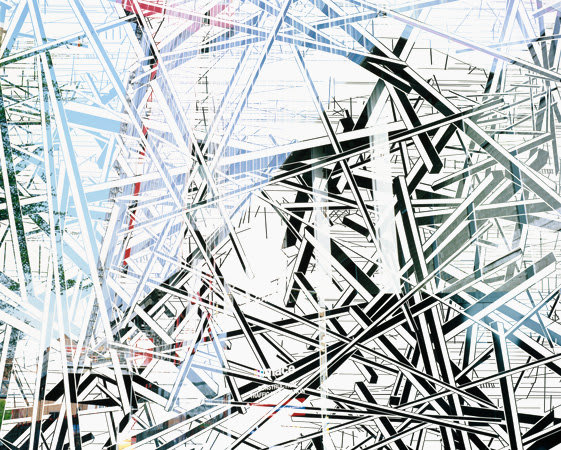Let Us Build Us a City and a Tower: Richard Galpin
London 2011. A scattering of tall buildings, most of which have been in planning for nearly a decade, have begun to rise. Despite the world economic crisis, these huge beacons of power and wealth continue to be built in anticipation of the next financial upturn. The London skyline changes…
From a studio in the narrow back streets of the Bankside area (an area itself scheduled for a staggering five million square feet of office development) Richard Galpin makes regular forays through the city to monitor development. Drawn to the army of cranes and the emerging skeletons of building structures, he sets his camera tripod before the hoardings of the The Shard, The Pinnacle, The Leadenhall Building, NEO Bankside…
However, the pictures which emerge from the studio after the film is developed, the prints enlarged, and their surfaces scored and scoured by hundreds of scalpel blades, show an altogether different future city. Post and prop, brace and cross-brace. A ferment of horizontal, vertical and skewed elements, seemingly built with a great excess of material, with haste, and the crudest of means. No space frames, no lift shafts, no glass facades. Half built, half collapsed; emerging forms threaten to fall…
But parts of this u/dys-topian scene, this 'world behind the world', have been seen before. Lurking in the works are Iakov Chernikhov's architectural fantasies, incorporating thrusting machine forms (1925-1933), and Constant Nieuwenhuy's New Babylon project for a post-revolutionary society (1959-74). And Galpin's haunted future never gets very far from the present, due to the partial nature of the erasure. Each remaining photographic element, every building block of the new city, is a ruined fragment of contemporary London…
'Come, Let Us Build Us a City and a Tower' say the people of one language in the story of the Tower of Babel. Does Galpin's work warn of the hubris of human ambition? Is it a critique of the current trend of starchitecture icons? Perhaps, but the work is foremost a celebration of the sublime, heroic, romantic aura of attempts to build a better world (however ill-fated those attempts turn out to be). It seems to call out, in the oft-quoted words of Samuel Beckett's 'Worstward Ho',"Try again. Fail again. Fail better."*
*e.g. Zizek on Lenin in 'How to Begin from the Beginning' in The Idea of Communism, Verso,2010.
This is Richard Galpin's fourth solo exhibition with Hales Gallery. Since graduating from Goldsmiths College with an MA in 2001, Richard Galpin has had solo exhibitions at Franklin Art Works (Minneapolis), Brancolini Grimaldi Arte Contemporanea (Rome), Galeria Leme (Sao Paulo), Roebling Hall (New York) and Hales Gallery (London). Recent group exhibitions include Marlborough Chelsea, (New York), Norton Museum of Art, (Florida), Brazilian British Centre Galleries, (Sao Paulo), the Knoxville Museum of Art, (Tennessee), and the Victoria and Albert Museum, (London). His work is included in public collections including the British Government Art Collection, the British Museum, and the Victoria and Albert Museum. In 2010 he completed his first public commission 'Viewing Station' for the High Line, a new elevated public park on a disused freight track in New York.
-

Brace II (City Gate), 2011, peeled photograph, 95x109cm
-

Brace III (Breach), 2011 peeled photograph 76 x 95 cm
-

Stem (Vault), 2011 peeled photograph 58 x 69 cm
-

Brace IV (Transmitter), 2011 peeled photograph 89 x 80 cm
-

Brace I (Tract), 2011 peeled photograph 125 x 220 cm
-

Brace V (Boom), 2011 peeled photograph 44.2 x 43.7 cm
-

Brace VI (Bastion), 2011 peeled photograph 118 x 80 cm
-

Stem II (Span), 2011 peeled photograph 80 x 142 cm
-
 Let Us Build Us a City and a Tower, 2011, Installation shot
Let Us Build Us a City and a Tower, 2011, Installation shot -
 Brace I (Tract) (Installation view), 2011, peeled photograph 125 x 220 cm
Brace I (Tract) (Installation view), 2011, peeled photograph 125 x 220 cm -
 Let Us Build Us a City and a Tower, 2011, Installation shot
Let Us Build Us a City and a Tower, 2011, Installation shot -
 Brace VI (Bastion) (Installation view), 2011, peeled photograph 118 x 80 cm
Brace VI (Bastion) (Installation view), 2011, peeled photograph 118 x 80 cm













